The Intel Haswell-E CPU Review: Core i7-5960X, i7-5930K and i7-5820K Tested
by Ian Cutress on August 29, 2014 12:00 PM ESTGaming Benchmarks
One of the important things to test in our gaming benchmarks this time around is the effect of the Core i7-5820K having 28 PCIe 3.0 lanes rather than the normal 40. This means that the CPU is limited to x16/x8 operation in SLI, rather than x16/x16.
F1 2013
First up is F1 2013 by Codemasters. I am a big Formula 1 fan in my spare time, and nothing makes me happier than carving up the field in a Caterham, waving to the Red Bulls as I drive by (because I play on easy and take shortcuts). F1 2013 uses the EGO Engine, and like other Codemasters games ends up being very playable on old hardware quite easily. In order to beef up the benchmark a bit, we devised the following scenario for the benchmark mode: one lap of Spa-Francorchamps in the heavy wet, the benchmark follows Jenson Button in the McLaren who starts on the grid in 22nd place, with the field made up of 11 Williams cars, 5 Marussia and 5 Caterham in that order. This puts emphasis on the CPU to handle the AI in the wet, and allows for a good amount of overtaking during the automated benchmark. We test at 1920x1080 on Ultra graphical settings.
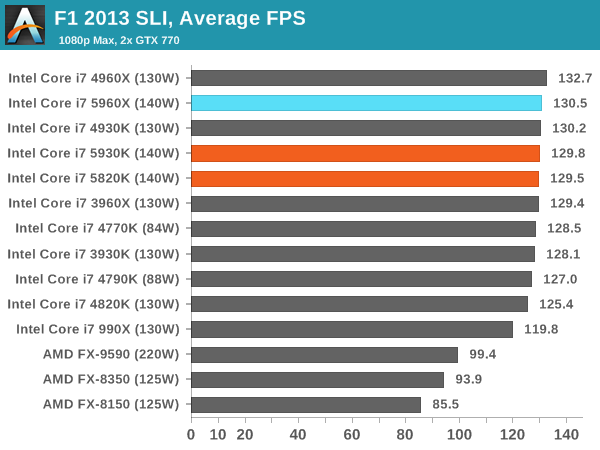
Nothing here really shows any advantage of Haswell-E over Ivy Bridge-E, although the 10% gaps to the 990X for minimum frame rates offer some perspective.
Bioshock Infinite
Bioshock Infinite was Zero Punctuation’s Game of the Year for 2013, uses the Unreal Engine 3, and is designed to scale with both cores and graphical prowess. We test the benchmark using the Adrenaline benchmark tool and the Xtreme (1920x1080, Maximum) performance setting, noting down the average frame rates and the minimum frame rates.
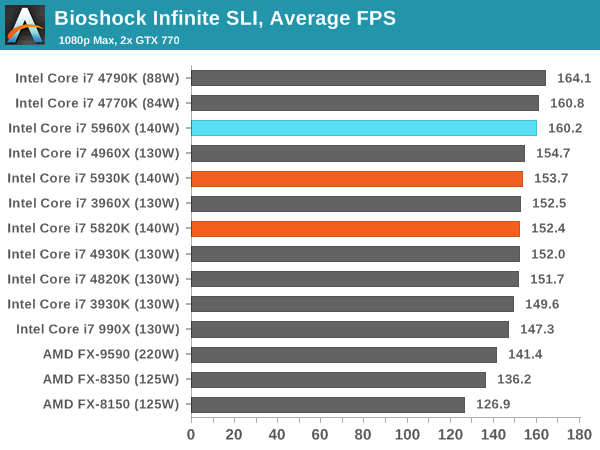
Bioshock Infinite likes a mixture of cores and frequency, especially when it comes to SLI.
Tomb Raider
The next benchmark in our test is Tomb Raider. Tomb Raider is an AMD optimized game, lauded for its use of TressFX creating dynamic hair to increase the immersion in game. Tomb Raider uses a modified version of the Crystal Engine, and enjoys raw horsepower. We test the benchmark using the Adrenaline benchmark tool and the Xtreme (1920x1080, Maximum) performance setting, noting down the average frame rates and the minimum frame rates.
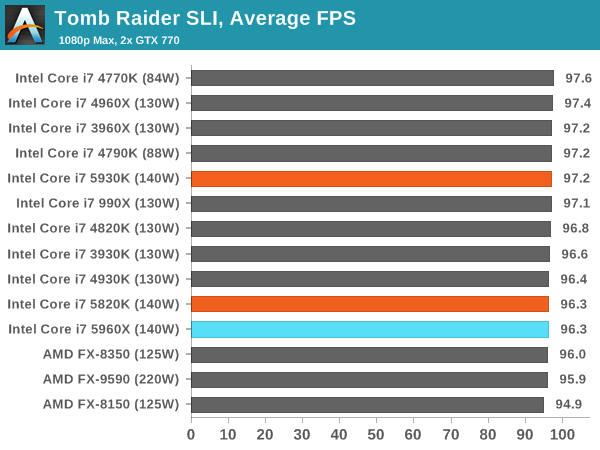
Tomb Raider is blissfully CPU agnostic it would seem.
Sleeping Dogs
Sleeping Dogs is a benchmarking wet dream – a highly complex benchmark that can bring the toughest setup and high resolutions down into single figures. Having an extreme SSAO setting can do that, but at the right settings Sleeping Dogs is highly playable and enjoyable. We run the basic benchmark program laid out in the Adrenaline benchmark tool, and the Xtreme (1920x1080, Maximum) performance setting, noting down the average frame rates and the minimum frame rates.
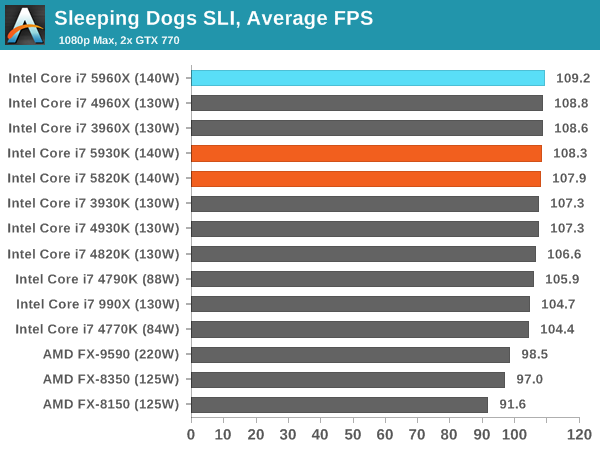
The biggest graph of CPU performance change is the minimum frame rate while in SLI - the 5960X reaches 67.4 FPS minimum, with only the xx60X CPUs of each generation moving above 60 FPS. That being said, all the Intel CPUs in our test are above 55 FPS, though it would seem that the 60X processors have some more room.
Battlefield 4
The EA/DICE series that has taken countless hours of my life away is back for another iteration, using the Frostbite 3 engine. AMD is also piling its resources into BF4 with the new Mantle API for developers, designed to cut the time required for the CPU to dispatch commands to the graphical sub-system. For our test we use the in-game benchmarking tools and record the frame time for the first ~70 seconds of the Tashgar single player mission, which is an on-rails generation of and rendering of objects and textures. We test at 1920x1080 at Ultra settings.
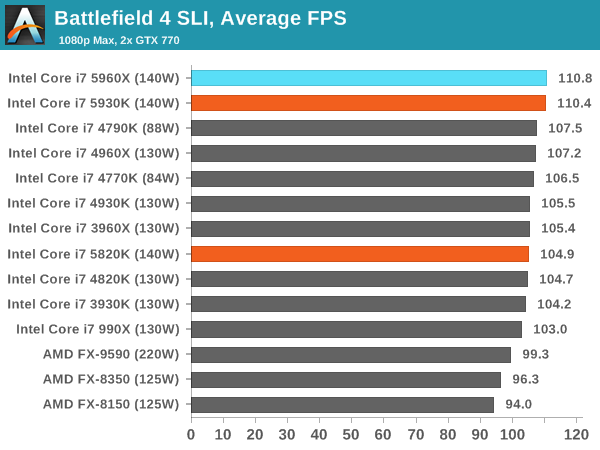
Battlefield 4 is the only benchmark where we see the 5820K with its 28 PCIe lanes down by any reasonable margin against the other two 5xxx processors, and even then this is around 5% when in SLI. Not many users will notice the difference between 105 FPS and 110 FPS, and minimum frame rates are still 75 FPS+ on all Intel processors.















203 Comments
View All Comments
MrBungle123 - Friday, August 29, 2014 - link
Is there anything but 'edge case' justification for upgrading any more? PCs used to be exciting because things were always changing, this is just getting boring.edzieba - Friday, August 29, 2014 - link
VR. The frame rendering time requirements are pretty stringent. This is more on the GPU than the CPU for graphics, but you want to try and keep physics tics at a good rate to prevent objects jumping around the world.tech6 - Friday, August 29, 2014 - link
Even the 'edge case' is not longer a slam dunk as most workstation workloads like CAD do very well on the 4960X.The only real cases are heavy scientific number crunching, animation rendering and cracking password hashes by brute force.
MrBungle123 - Friday, August 29, 2014 - link
It used to be that if you were 2 generations behind your system was so slow and irrelevant that you just couldn't run modern software at anything approaching an acceptable level. Now we have a situation where ancient systems on X58 (circa 2008) are still close enough in performance to the extreme high end in 2014 to not only be in this review but also fit somewhere into the top half of the product stack of modern Haswell based hardware.If you compare a top of the line Nehalem chip to its equivalent from 6 years prior (a Northwood core P4 from 2002) it would make a mockery of 8 of them at the same time. This article is saying a 31% jump from Nehalem to Haswell-E -- that kind of performance increase (as a percentage) would have amounted to 2 or 3 months worth of clock speed bumps at any other time in the history of PCs.
wireframed - Friday, August 29, 2014 - link
Somewhat true, but consider that you get 30% IPC increase, 25-30% frequency increase and a 50% core-count increase, and it adds up to around a 100% increase in performance.Granted, 100-110% over 6 years is hardly impressive compared to earlier, but there isn't that much low-hanging fruit.
Also, the mainstream which drives revenue is, as you point out, largely content. They're looking at adding devices like tablets and consoles, instead of upgrading their computers. That probably plays into the amount of R&D Intel decides to spend on the HEDT platform.
Kain_niaK - Friday, August 29, 2014 - link
Exactly exactly exactly! I am still on X58 with a i7 990x. I don't play much games any more but even to play the newest games ... I do not need to upgrade my CPU and have not needed to upgrade my CPU since 2010. And even my i7 975x or a i7 920 from 2008 would still be more then fast enough. Then music. I use my system mainl as Digital Audio Workstation. Most of my plugins and music applications support multithreading. I cannot realistically ad so much stuff to a project that it maxes out the CPU. And rendering time? Who cares, most of my renders are done before I am done playing chess on the toilet anyway. Then overclocking. The i7 920 and anything on X58 was great. After that ... the fun and the excitement kind of went away and has never come back. What's the SUPERPI MOD record these days? I have not heard about any significant record breaking for a long time. Back in 2008, 2009,2010 I was hearing news about famous new overclock records. After that, it stopped. Let's face it. We hit a clock limit and for a breaktrought in singlethreated speed ... it's just not gonna happen until some genius designs a totally different system. Probably not using electricity but light. But that's like 20 years away because you don't just start over. All we have been doing is improving old technology not inventing something completely new. We are hitting the limits of nature ... so all the geeks and the nerds will just have to way at least another 10 years before we get to the exciting stuff again.MrBungle123 - Friday, August 29, 2014 - link
At this rate 10 years from now any Haswell i7 is still going to be within spitting distance of whatever the best is. lolIf you wan't Skylake performance today OC your Haswell by 250MHz, Ivy Bridge by 400MHz, or Sandy Bridge by 600MHz.
Laststop311 - Saturday, August 30, 2014 - link
it wont be the cpu performance difference that makes u upgrade it will be the new features. Skylake will have pci-e 4.0 and usb 3.1 and then chipsets after that will add more new things faster storage standards and who knows what else.I was already in this position. The speed of the i7-980x was still rly good. Got mine oc'd to 4261mhz. But guess what on x58 you get not pci-e3.0 no sata 3 no usb 3.0. These features have become very standard. You also get no sata express or pci-e ultra m2 which will soon be commonplace as well as no quad channel memory and no ddr4. All the missing features made me upgrade, not the speed. Similar situations in the future will cause people to upgrade every 4-6 years.
TiGr1982 - Tuesday, September 2, 2014 - link
You can still plug the PCIe USB 3.0 extension board there and get at least 2 USB 3.0 ports on the back of the case, to somewhat mitigate the age of the platform.But, with PCIe 2.0 and SATA 2, one is stuck, indeed.
actionjksn - Saturday, August 30, 2014 - link
Nehalm was great, but the last big bump was really Sandy Bridge. After that, not so much. This is actually a big concern for the processor makers. The technology and the silicon itself is reaching its limits as far as making significant gains on the next generations. They were getting big performance gains from just die shrinks alone, but those days are over. And how much more can they shrink them? It's getting harder all the time, they may get to 7nm to 10nm.